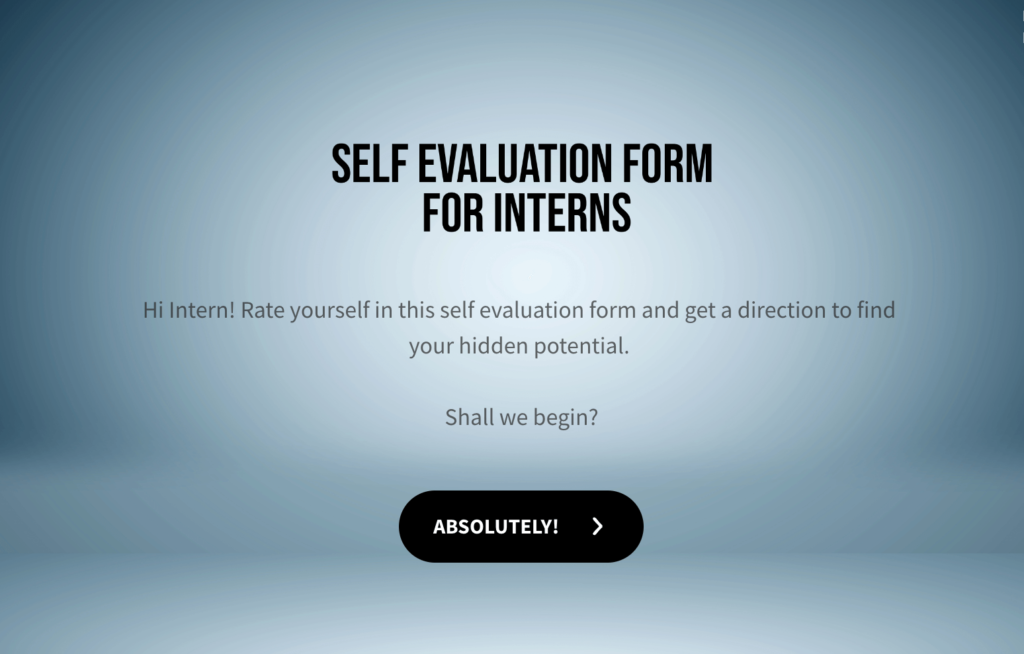Employee Experience
How to Write a Self-Evaluation for Work: Tips & Examples to Help You Nail It
Article written by Parvathi Vijayamohan
Content marketer at SurveySparrow.
8 min read
19 September 2025

If you’re looking for tips on how to write a self-evaluation, you’ve come to the right place.
To break it down, you have to sum up your achievements and mistakes over the course of the year. Moreover, you have to objectively present them in a way that’s balanced and honest.
Self-evaluations are a core element of 360 degree performance reviews. So they also help HR teams make decisions on promotions, role changes and raises. It’s only natural to worry about getting them right.
In order to make this process easy, we will lay out three simple steps spaced out over a year.
- How to Write a Self-Evaluation: Step 1: Start a Year in Advance
- Step 2: Prepare the data 1-3 months before the review
- Step 3: Bring it all together during self-review
- Bonus: Survey Template for Practice
How to Write a Self-Evaluation (Examples Included)
How to Write a Self-Evaluation – Step 1: Start a Year in Advance
#1A. Note down your accomplishments as they happen
Ever sat down for self-evaluation only to find that your brain – that “complicated organization of matter” in Asimov’s words – is totally blank? Given how much we seem to forget daily, it’s a miracle if we can instantly recall anything that happened months ago.
To avoid the dreaded ‘mind-blank’, deliberately set aside a few minutes every week to note down your accomplishments. Of course, you can also note stuff down in real-time. They can include the following:
- What were the goals for that week/month? How did you go about achieving them?
- How have you tried to improve yourself?
- If there was a challenging situation, how did you respond to it?

Another neat jotting technique is the Situation – Behavior – Impact outline. Let’s use some self-evaluation examples to see how we should apply this outline:
- Situation: Provide the who, where, when, and why of the situation
Example: During the run-up to Christmas this past December, I asked to lead the team’s brainstorming session for campaign ideas.
- Behavior: How did you respond?
Example: I took the initiative to schedule the meetings and also coordinated with the media and sales ops teams for our campaign promotion.
- Impact: How did your response contribute to the result?
Example: We generated three campaign ideas, one of which was produced in-house and got over 150,000 shares, 1 million views, and a 30% increase in footfalls.

#1B. Make a list of your struggles and challenges
It’s natural to want to portray only your best in a self-appraisal. But there is always a point when you face challenges that affect your performance, and you have to talk about them.
Here’s a tip: use positive language to describe your struggles on the job. You don’t want to emphasize your failures but to show how they helped you grow. And whenever possible, highlight your own solution to the problem.
Example: I frequently failed to reach my monthly targets.
This is an example of negative language. Let’s rewrite this to be more constructive.
Example: Several missed targets helped me identify my time management struggles. I’ve started creating daily task lists with timelines to stay on track.
This step helps you demonstrate your ability to hold yourself accountable and seek a solution – two traits that signal leadership material. But if you were unable to find a solution to the issue, don’t hesitate to bring it up anyway. It could point to deeper organizational issues that are holding you back.
Step 2: Prepare the data 1-3 months before the review
#2A. Get the numbers if you can
At this time, HR would have informed you about the upcoming 360 performance review. Therefore, it’s time to scan your achievement log and support the accomplishments with numbers wherever needed.
According to Kamara Toffolo, LinkedIn consultant, “Numbers convey impact quickly, efficiently, and can transcend language.”
“But slapping a number on an accomplishment just to quantify it doesn’t suddenly make it more relevant and powerful,” adds Toffolo. “The use of a number needs to make sense, and often, it doesn’t. There are many situations where you can’t quantify an accomplishment, and some cases where you shouldn’t even try.”
So, you need to include only the figures that add value to your work – like the metrics and KPIs you were chasing this year. Here’s a self-evaluation example:
“I exceeded my lead closure rates by 30% in 2021.”

#2B. Align your achievements with the company goals
One good way to highlight your track record is to reflect on the company’s goals for that year and how your work contributed to achieving them.
“Clear goals and objectives allow employees to monitor their own progress all year ’round and correct their efforts as necessary,” explains Dan Feliciano, President of OpEx90. “If employees know what they need to accomplish, they can look at their results as they go and identify barriers to achieving those goals.”
Here’s a self-evaluation example that aligns with a company goal:
“We reduced customer returns/rejects by 60% as part of Z Corp’s quality improvement program.”
Step 3: Bring it all together during self-review
#3A. Take your time
Dominique Jones, CEO of BetterU Skills, recommends treating your self-evaluation like a work of art. “You’ll be much happier with the result if you give yourself time to reflect and carefully support your self-assessment,” says Jones. This makes sense – if you don’t advocate for yourself, who will?
With that in mind, you need to remember the following rules while crafting your self-evaluation sample:
- Give yourself a week if possible to work on your self-evaluation.
- If you didn’t achieve your goals for this year, own it. This review is about you, so refrain from finger-pointing or blaming others.
- If you have a problem with a coworker that you feel affects your performance, keep that for a separate, private conversation with your manager. Ideally, you should do this way before the 360 evaluation.
- Check your self reviews for spelling, grammar, and tone.
Here’s a tip: Before you submit your review, you can run it through tools like Grammarly’s tone detector plug-in or IBM Watson’s Tone Analyzer. They will help you find the right balance and language style. For added precision, incorporating alternate solutions can enhance clarity and accuracy. Consider using a Grammar checker free to ensure your self-evaluation is error-free and polished.

#3B. Chart out your improvement plan
Before you turn in your self-review, think about what you’re going to improve and how you will do it. Then, follow these four steps to address it on your self-evaluation.
1. Acknowledge your flaws.
2. Set a SMART goal to address them. You can read about SMART goals here.
3. Make a plan. There are plenty of free and low-cost resources to help you figure this out. First, however, research which ones will deliver the results you’re looking for. Here are six resources to get you started:
- SCORE.com for local workshops and courses on demand.
- Udemy Free Resource Center and edX for free online courses.
- Corporate mentorship programs like Boeing’s 1-to-1 peer mentoring program.
- Virtual and in-person business networks like LinkedIn Groups, Meetup, and Let’s Lunch.
- Business ebooks and podcast libraries like The Entrepreneurs Library.
- TED Talks and YouTube videos on the subject.
4. Track your progress. This is easy for your manager if they use 360-degree software like SurveySparrow for performance reviews because it comes with automatic reporting and insights. However, nothing can beat the satisfaction of seeing your progress for yourself.
How to Write a Self-Evaluation: Template for Practice
Here’s a free, customizable self-evaluation template by SurveySparrow. Simply create a free account below to start using this plus hundreds of other free survey templates.
14-day free trial • Cancel Anytime • No Credit Card Required • No Strings Attached
Wrapping up
Most employees dread self-evaluations because it is hard to view oneself objectively. In the article, we talked about the six steps of how to write a self-evaluation that will let your work shine. Good luck with your performance review!

Get upto 40% more responses on your employee surveys. Start your free trial today!
Parvathi Vijayamohan
Parvathi is a sociologist turned marketer. After 6 years as a copywriter, she pivoted to B2B, diving into growth marketing for SaaS. Now she uses content and conversion optimization to fuel growth - focusing on CX, reputation management and feedback methodology for businesses.
Related Articles

Employee Experience
15 Reasons Why You Shouldn't Ignore Employee Experience
15 MINUTES
24 November 2020

Employee Experience
10 Remote Employee Recognition Ideas That Always Work
8 MINUTES
24 July 2020

Employee Experience
An Essential Guide to Remote Work Communications: 14 Super Actionable Tips
14 MINUTES
8 September 2020

Employee Experience
How to Perform an Effective Performance Review
6 MINUTES
8 February 2020
